 The AK-47 Kalashnikov Assault Rifle is a gas-operated assault rifle that was used in many Eastern bloc nations during the Cold War. Adopted and standardized in 1947, it was designed by Mikhail Kalashnikov and produced by Russian manufacturer Izhevsk Mechanical Works. Compared with the auto-loading rifles used in World War II (the StG-44 aside), the AK-47 was generally more compact, with a shorter range, a smaller 7.62 × 39 mm cartridge, and was capable of selective fire. It was one of the first true assault rifles and remains the most widely used and known. This was a widely used and popular weapon with the VC and NVA forces. More AK-47 rifles have been produced than any other assault rifle; production continues to this day.
The AK-47 Kalashnikov Assault Rifle is a gas-operated assault rifle that was used in many Eastern bloc nations during the Cold War. Adopted and standardized in 1947, it was designed by Mikhail Kalashnikov and produced by Russian manufacturer Izhevsk Mechanical Works. Compared with the auto-loading rifles used in World War II (the StG-44 aside), the AK-47 was generally more compact, with a shorter range, a smaller 7.62 × 39 mm cartridge, and was capable of selective fire. It was one of the first true assault rifles and remains the most widely used and known. This was a widely used and popular weapon with the VC and NVA forces. More AK-47 rifles have been produced than any other assault rifle; production continues to this day.
Type: Assault Rifle
Place of Origin: Soviet Union
Designer: Mikhail Kalashnikov
Designed: 1947
Number Built: Over 10 million
Weight: 3.8 Kg (9.5lb) empty, 4.3Kg loaded
Length: 870 mm (34¼)
Barrel Length: 415 mm (16.3 in)
Cartridge: 7.62×39 mm
Action: Gas-operated, rotating bolt
Rate of Fire: 600 rounds/min
Muzzle Velocity: 710 m/s (2,330 ft/s)
Effective Range: 300 m (330 yd) Feed System: 30-round detachable box compatible w/RPK 40-round box, 75-round drum magazine.
Sights: Adjustable iron sights, optional mount required for optical sights.
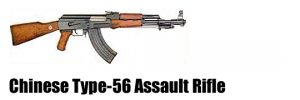 The Type 56 Assault Rifle is a Chinese copy of the Kalashnikov AK-47. While early Type 56s were copies of the third generation milled receiver AK-47, later Type 56s were patterned after the improved AKM with stamped receivers. Visually, all versions of the Type 56 are distinguished from the AK-47 and AKM by the fully-enclosed hooded front sight (Russian-made rifles have a partially open front sight) and the smooth receiver cover, a characteristic of only the earliest Russian AKs. Some versions of the Type-56 also have a folding “spike” bayonet attached to the barrel just aft of the muzzle, and others have a rounded pistol grip similar in design to that of the Czech Sa 58. Also, the receiver metal is thinner than the AK-47 in order to reduce costs, though this also reduces durability.
The Type 56 Assault Rifle is a Chinese copy of the Kalashnikov AK-47. While early Type 56s were copies of the third generation milled receiver AK-47, later Type 56s were patterned after the improved AKM with stamped receivers. Visually, all versions of the Type 56 are distinguished from the AK-47 and AKM by the fully-enclosed hooded front sight (Russian-made rifles have a partially open front sight) and the smooth receiver cover, a characteristic of only the earliest Russian AKs. Some versions of the Type-56 also have a folding “spike” bayonet attached to the barrel just aft of the muzzle, and others have a rounded pistol grip similar in design to that of the Czech Sa 58. Also, the receiver metal is thinner than the AK-47 in order to reduce costs, though this also reduces durability.
The Chinese Type 56 assault rifle has been the standard issue assault rifle of the Chinese military from the late 1950’s until the 1980’s when it was replaced by the newer Type 81 assault rifle and the rifles were sent to second-line Chinese forces. During the Cold War period, the Chinese Type 56 assault rifle was exported by the Chinese to communist forces in the Third World that were loyal to Maoism and Beijing. During the Soviet war in Afghanistan in the 1980’s, many Chinese Type 56 assault rifles were given to Afghan guerrillas to fight Soviet forces in Afghanistan by both the Chinese and the Americans. When the Taliban took control of Kabul in 1996, the Chinese Type 56 assault rifle were seen in the hands of Taliban forces while the Afghan Northern Alliance forces were exclusively armed with Russian-made Kalashnikovs e.g. the AKM and the AK-74.
Type: Assault Rifle
Place of Origin: People’s Republic of China
In Service: 1958 to 1986
Used By: People’s Republic of China, Sri Lanka, Republic of Croatia
Wars: Vietnam War, Sri Lankan Civil War, Soviet War in Afghanistan, Croatian War of Independence.
Designed: Unknown
Produced: 1956 to present
Number Built: Millions.
Weight: 3.8Kg
Length: 874 mm (34.4 in)
Barrel Length: 414 mm (16.3 in).
Cartridge: 7.62 mmx39 mm Soviet M1943
Action: Gas-operated, rotating bolt
Rate of Fire: 600r/min
Muzzle velocity: 735 m/s (2,411 ft/.s)
Effective Range: 400 m
Feed System: 30 round standard
Sights: Adjustable iron sights.
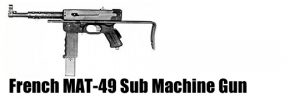 MAT-49 submachine gun was developed at the French state arms factory MAT (Manufacture Nationale d’Armes de Tulle) in the late 1940s, and was adopted by the Armee de Terre (French Army) in 1949. First batches were delivered in 1950, and production of the MAT-49 continued at Tulle until mid-1960s, when it was transferred to the MAS factory at the St. Etienne. Production was ceased in about 1979, when French army officially adopted the FAMAS assault rifle. For some 30 years the MAT-49 was widely used by French military and police forces, and it was brought through the Indo-China and Algeria campaigns, and it still could be encountered in ex-French colonies in Africa and Indo-China. It should be noted that North Vietnamese once produced local copy of the MAT-49, chambered for 7.62mm TT round. MAT-49 is no longer used by French army, but still can be sometimes seen in the hands of the Police and Gendarmerie officers. For police use, MAT also produced a specialized version, known as MAT-49/54. This was fitted with longer barrel and with selective fire mechanism with dual triggers.
MAT-49 submachine gun was developed at the French state arms factory MAT (Manufacture Nationale d’Armes de Tulle) in the late 1940s, and was adopted by the Armee de Terre (French Army) in 1949. First batches were delivered in 1950, and production of the MAT-49 continued at Tulle until mid-1960s, when it was transferred to the MAS factory at the St. Etienne. Production was ceased in about 1979, when French army officially adopted the FAMAS assault rifle. For some 30 years the MAT-49 was widely used by French military and police forces, and it was brought through the Indo-China and Algeria campaigns, and it still could be encountered in ex-French colonies in Africa and Indo-China. It should be noted that North Vietnamese once produced local copy of the MAT-49, chambered for 7.62mm TT round. MAT-49 is no longer used by French army, but still can be sometimes seen in the hands of the Police and Gendarmerie officers. For police use, MAT also produced a specialized version, known as MAT-49/54. This was fitted with longer barrel and with selective fire mechanism with dual triggers.
The Communists captured many 9mm sub machine guns from the French. These were converted to take the 7.62mmx25mm cartridge by fitting a longer barrel
Type: Sub Machine Gun
Place of Origin: France
In Service: 1949
Designed: Unknown
Produced: 1956 to present
Weight: 3.63Kg
Length: (Stock retracted) 404 mm
Length: (Stock Extended) 660 mm
Barrel Length: 230 mm (5.75 in).
Cartridge: 9 mm Parabellum
Rate of Fire: 600r/min
Muzzle velocity: 390 m/s (1,280 ft/.s)
Effective Range: 100 m
Feed System: 20 or 32 rounds box magazine.
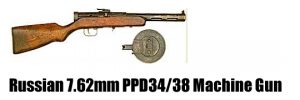
The PPD is a submachine gun originally designed in 1934 by Vasily Degtyaryov. It was a near direct copy of the German Bergmann MP28, and it utilized a large ammunition drum, itself a copy of the Finnish M31 Suomi drum magazine. It first went into military service in 1935 as the PPD-34. In 1938 and 1940, modifications were designated PPD-34/38 and PPD-40 respectively, and introduced minor changes. Nevertheless, the PPD-40 was too complicated and expensive to mass-produce, and although it was used in action in the initial stages of World War II, it was, by the end of 1941, quickly phased out and replaced by the superior and cheaper PPSh-41. This weapon was used by both the VC and NVA.
Type: Sub Machine Gun
Place of Origin: Soviet Union
In Service: 1935 to 1941
Designer: Vasily Degtyaryov
Designed: 1934
Variants: PPD-34, PPD-34/38, PPD-40
Weight: 3.63 Kg
Length: 788 mm
Barrel Length: 273 mm
Cartridge: 7.62 x 25 TT
Action: Blowback, Open Bolt
Muzzle Velocity: 489 m/s
Rate of Fire: 800 r/min
Feed System: 25 round detachable box magazine, 71 round detachable box magazine.
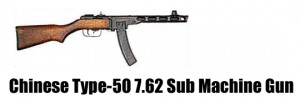 Like many of the weapons used by Communist China, their sub-machine gun Type 50 had its origins in a weapon first produced by the Soviet Union, in this case the PPSh 41. As with most other combatant nations the Russians soon saw the need for mass production and the new gun was largely made of heavy gauge stampings, welded, pinned and brazed as necessary. The gun was of normal blowback mechanism and had the interior of the barrel chromed, a fairly common Soviet device. One of its distinctive features is that the front end of the perforated barrel casing slopes steeply backward from top to bottom, thus acting as a compensator to keep the muzzle down. In spite of its high cyclic rate of fire the gun was reasonably accurate and could be fired in single rounds if required.
Like many of the weapons used by Communist China, their sub-machine gun Type 50 had its origins in a weapon first produced by the Soviet Union, in this case the PPSh 41. As with most other combatant nations the Russians soon saw the need for mass production and the new gun was largely made of heavy gauge stampings, welded, pinned and brazed as necessary. The gun was of normal blowback mechanism and had the interior of the barrel chromed, a fairly common Soviet device. One of its distinctive features is that the front end of the perforated barrel casing slopes steeply backward from top to bottom, thus acting as a compensator to keep the muzzle down. In spite of its high cyclic rate of fire the gun was reasonably accurate and could be fired in single rounds if required.
The earliest versions had a tangent backsight but this was soon replaced by a simpler flip sight. The Chinese Communists received many of these guns in and after 1949 and started their own large scale manufacture of them in 1949 or 1950. Their version was essentially similar to its Russian counterpart, but had a somewhat lighter stock. It is also designed to take a curved box magazine though it will also fire the 71-round drum which was the standard magazine on the original Russian model. All Chinese versions have the two-range flip sight. The first locally-made weapons were crude in the extreme and gave the impression of having been made by apprentice blacksmiths (as perhaps they were). Nevertheless they worked, which was the first and only requirement of the Chinese.
The Type 50 was used extensively by the Chinese in the Korean war where it earned the inelegant but expressive nickname ‘burp-gun’ from its high rate of fire. Many were also used against the French in Indo-China in the 1950s.
Length: 858 mm (33.75 in)
Weight: 3.63 Kg (8 lb)
Barrel: 273 mm (10.75 in)
Calibre: 7.62 mm
Feed System: 35-round box magazine
Rate of Fire: 900 rpm
Muzzle Velocity: 473 m/s (1,400 ft/s)
Sights: 110-219 yds.
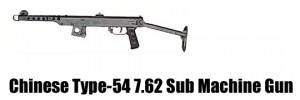 The origins of this particular weapon are unusual, since it was designed by A. Sudarev at Leningrad in 1942 when the city was under actual blockade by the Germans. Arms were in short supply and as none could be brought in it became necessary to improvise from local resources. The new gun, originally known as the Russian PPS 42, was therefore made in the city itself, so that weapons coming off the production line were liable to be used in action after a matter of hours.
The origins of this particular weapon are unusual, since it was designed by A. Sudarev at Leningrad in 1942 when the city was under actual blockade by the Germans. Arms were in short supply and as none could be brought in it became necessary to improvise from local resources. The new gun, originally known as the Russian PPS 42, was therefore made in the city itself, so that weapons coming off the production line were liable to be used in action after a matter of hours.
As was to be expected the gun was made of stampings, using any suitable grade of metal, and was held together by riveting, welding and pinning. Nevertheless it was not only cheap but it turned out to be effective. It worked on the usual simple blowback system and would only fire automatic; perhaps its oddest feature was its semi circular compensator, which helped it to keep its muzzle down but increased blast considerably. This was followed by the PPS-43, modified and improved by the same engineer who had been responsible for the earlier model. Its most unusual feature was was that it had not separate extractor in the normal sense of the word. The bolt moved backwards and forwards along a guide rod which was of such a length that as the bolt came back with the empty case, the end of the rod caught it a sharp blow and knocked it clear.
After the Chinese revolution of 1949, the Soviet Union naturally supplied its new ally with a considerable quantity of arms including large numbers of the PPS-43, and by 1953 the Chinese had begun large-scale manufacture of these weapons, virtually unchanged in appearance from the Russian prototypes. The only way in which it can be distinguished is by the fact that the plastic pistol grips often bear a large letter K in a central design. This, however, is by no means universal and other designs, including a diamond, may be found. The gun is still often found in South East Asia.
Length: 819 mm (32.25 in)
Weight: 3.36 Kg (7.4 lb)
Barrel: 254 mm (10 in)
Calibre: 7.62 mm
Feed System: 35-round box magazine
Rate of Fire: 700 rpm
Muzzle Velocity: 488 m/s (1,600 ft/s)
Sights: Flip. 110-219 yds.
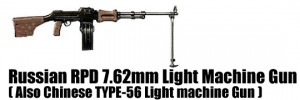 The RPD was developed for the Russian military in 1944 for use as a squad automatic weapon (SAW), and entered service during the 1950s. It can be fired from a prone position with the built-in bipod, or from the hip with the aid of a sling. It is fed by refillable non-disintegrating links. The RPDM is a product-improved and modernized version which was introduced in the mid 1950s. In China, the RPD was manufactured with minor internal modifications and was named Type 56 LMG and was even exported to Sri Lanka.
The RPD was developed for the Russian military in 1944 for use as a squad automatic weapon (SAW), and entered service during the 1950s. It can be fired from a prone position with the built-in bipod, or from the hip with the aid of a sling. It is fed by refillable non-disintegrating links. The RPDM is a product-improved and modernized version which was introduced in the mid 1950s. In China, the RPD was manufactured with minor internal modifications and was named Type 56 LMG and was even exported to Sri Lanka.
The Type 56 LMG saw widespread use in the hands of VPA and NLF forces in the Vietnam war. The RPD was replaced by Soviet Army in the late 1960s by the RPK, much to many infantry soldiers dismay, though was still used in the reserves for some years. Today the RPD is still widely used by many guerrilla organizations around the world, notably the Tamil Tigers.
Type: Light Machine Gun
Place of Origin: Soviet Union
In Service: 1945-present
Used By: USSR, Member of the Warsaw Pact, Vietnam
Wars: Vietnam War, Afghanistan, various Middle East conflicts
Designed: 1944
Produced: 1944–1960s
Weight: 7.5 kg (16.5 lb) empty 8.9 kg (19.6 lb) w/ 100-rd drum
Length: 1,037 mm
Barrel length: 521 mm
Cartridge: 7.62×39 mm M43
Calibre: 7.62 mm
Action: Gas-operated
Rate of Fire: 650 round/min
Muzzle Velocity: 735 m/s
Feed System: 100-round drum.
 The RPG-7 (CHICOM Type-69) is a muzzle loaded, shoulder fired antitank grenade launcher. The VC and NVA used the RPG7V, a Soviet produced short-range, anti-Armour, rocket-propelled grenade, from 1967 against armoured vehicles, defensive positions, personnel and even helicopters. This smooth bore, recoilless weapon consists of a launcher tube fitted with a simple iron sight or a more sophisticated telescopic range-finding sight, and a HEAT rocket grenade projectile with a calibre of 40mm.
The RPG-7 (CHICOM Type-69) is a muzzle loaded, shoulder fired antitank grenade launcher. The VC and NVA used the RPG7V, a Soviet produced short-range, anti-Armour, rocket-propelled grenade, from 1967 against armoured vehicles, defensive positions, personnel and even helicopters. This smooth bore, recoilless weapon consists of a launcher tube fitted with a simple iron sight or a more sophisticated telescopic range-finding sight, and a HEAT rocket grenade projectile with a calibre of 40mm.
The RPG-7 has an effective range of 300 metres against moving targets and up to 500 metres against stationary targets. The projectile explodes either on impact or at its maximum range of 920 meters.
Calibre: 40 mm (1.57″)
Weight: 7 kg (15 lb)
Length: 95 cm (37″)
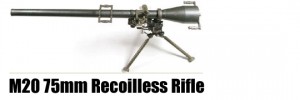 The M20 recoilless rifle was a U.S. 75 mm calibre recoilless rifle used during the last months of the Second World War and extensively during the Korean War. It could be fired from the shoulder, from a M1917A1 .30 calibre machine gun tripod, or from a vehicle mount, typically a Jeep. Its shaped charge warhead, also known as the HEAT, was capable of penetrating 100 mm of armour. This weapon could stop the Russian made T-34 tank at ranges up to 400 yards. It was used primarily as a close infantry support weapon to engage all types of targets including infantry and armoured vehicles. The M20 proved useful against pillboxes and other types of heavy fortifications.
The M20 recoilless rifle was a U.S. 75 mm calibre recoilless rifle used during the last months of the Second World War and extensively during the Korean War. It could be fired from the shoulder, from a M1917A1 .30 calibre machine gun tripod, or from a vehicle mount, typically a Jeep. Its shaped charge warhead, also known as the HEAT, was capable of penetrating 100 mm of armour. This weapon could stop the Russian made T-34 tank at ranges up to 400 yards. It was used primarily as a close infantry support weapon to engage all types of targets including infantry and armoured vehicles. The M20 proved useful against pillboxes and other types of heavy fortifications.
During World War II the U.S. military recognized that a powerful lightweight weapon was needed for defending infantry and light armour units due to advancements in armour technology by enemy forces. The Ordnance Department Small Arms Division commenced development of the a recoilless rifle and by 1944 models of a 75 mm recoilless rifle were being tested. Production of the M20 was underway by March 1945; only limited numbers were used by Allied troops on the European and Pacific theatres.
The M20 relied on a perforated artillery shell casing, combined with a rear vented breech using propellant gases from the firing of a shell, to greatly reduce the recoil of the weapon. It is this use of vented propellant gases that eliminated the need for a recoil system, thereby reducing the weight of the artillery piece and enhancing its use as a light infantry weapon.
Recoilless rifles, such as the M20, were used successfully in large numbers during the Korean War, but were phased out for the wired guided missiles introduced during the Vietnam War in the 1960’s and 1970’s
Again, very popular with the VC forces because of its combined firepower and light weight. A direct copy of the obsolete US M20. It was quite adequate for the needs of the VC.
Length: 6 ft 10 in (2.08 m)
Weight: 114.5 lb (52 kg)
Rifling: uniform right hand twist, 1 turn in 25
Range: (HEAT) 7000 yards (6.4 km)
Muzzle Velocity: (HEAT) 1000 ft/s (300 m/s)
Round weight: HE: 21.86 lb (9.92 kg), HEAT: 20.54 lb
(9.32 kg), Smoke (T40, WP): 22.61 lb (10.26 kg)
Armour Penetration: 4 inches (100 mm)
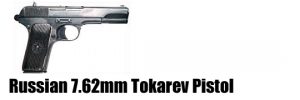 The TT-30 (7.62 mm Samozarjadnyi Pistolet Tokareva obraztsa 1933 goda), is a semi-automatic pistol developed by Fedor Tokarev for the Soviet military to replace the old Nagant M1895 revolvers in use since tsarist times. The TT-33 (Tokarev-Tula) was adopted in 1933 as an improved design of the TT-30, and was widely used by Soviet troops during World War II. Mechanically and externally, the TT-33 is very similar to John Browning’s blowback operated FN Model 1903 automatic pistol in design and function, combined with Browning’s short recoil principle and a much simpler hammer/sear assembly with an external hammer. This assembly is removable from the weapon as a single unit and includes cartridge guides that provide reliable functioning.
The TT-30 (7.62 mm Samozarjadnyi Pistolet Tokareva obraztsa 1933 goda), is a semi-automatic pistol developed by Fedor Tokarev for the Soviet military to replace the old Nagant M1895 revolvers in use since tsarist times. The TT-33 (Tokarev-Tula) was adopted in 1933 as an improved design of the TT-30, and was widely used by Soviet troops during World War II. Mechanically and externally, the TT-33 is very similar to John Browning’s blowback operated FN Model 1903 automatic pistol in design and function, combined with Browning’s short recoil principle and a much simpler hammer/sear assembly with an external hammer. This assembly is removable from the weapon as a single unit and includes cartridge guides that provide reliable functioning.
The Soviet Union delivered thousands of TT-30s to the Communist North Vietnamese regime during the Vietnam War.
Type: Semi-automatic pistol
Place of Origin: Soviet Union
In Service: 1930-1951
Designed: 1930 (TT-30)
Number Built: 1,700,000
Weight: 840 g
Length: 196 mm
Barrel Length: 116 mm
Cartridge: 7.62 x 25 mm TT (7.62 Tokarev)
Calibre: 7.62mm (.30″)
Action: Single action, recoil-actuated
Muzzle Velocity: 420 m/s
Feed System: 8 round box magazine
Sights: Blade (front), U-notch (rear).
